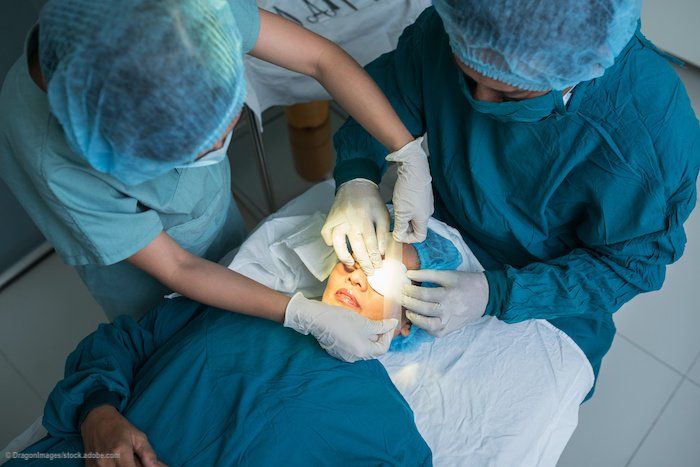Article
Combined cataract/EK surgery may require modifications to technique
Author(s):
Cataract surgery in eyes undergoing simultaneous endothelial keratoplasty requires several modifications in techniques.

Reviewed by Jessica B. Ciralsky, MD
When patients who are being considered candidates for endothelial keratoplasty (EK) also have a cataract, the first issue is to determine whether the surgeries should be done sequentially or simultaneously. Then, if the decision is to proceed with combined EK/cataract surgery, surgeons will need to modify their usual cataract technique to assure the safety and success of the grafting procedure, said Jessica B. Ciralsky, MD.

“It may be challenging to differentiate the cause of visual loss in a patient with both cataract and corneal disease, and perhaps the patient may not need both surgeries,” said Dr. Ciralsky, assistant professor of ophthalmology, Weill Cornell Medical College, New York.
“Alternatively, a patient may need keratoplasty and cataract surgery, but may have findings that make it difficult or dangerous to perform them both at a single session,” she said.
For example, if the cornea is so cloudy that intraocular visualization is poor, it may be necessary to wait to perform the cataract surgery. Or cataract surgery alone may be performed first if there are complicating factors, such as intraoperative floppy iris syndrome, hyperopia with a small anterior chamber, or zonular instability.
“The last thing you want is vitreous in the anterior chamber or an anterior capsule tear that extends when air is injected during the keratoplasty,” Dr. Ciralsky said.
A step-by-step guide
Each step of the cataract procedure may need to be modified when performing cataract surgery with EK, and the adjustment may differ depending on whether the patient is undergoing Descemet’s stripping automated endothelial keratoplasty (DSAEK) or Descemet membrane endothelial keratoplasty (DMEK).
Although surgeons may choose to perform combined cataract/EK surgery under topical anesthesia, Dr. Ciralsky said her preference is to use either peribulbar or retrobulbar anesthesia.
“I want to be sure the patient is comfortable and that the eye will not be moving,” she explained, adding that she also applies a Honan balloon to decrease positive posterior pressure.
For pupil dilation, Dr. Ciralsky uses her standard cataract surgery topical regimen when performing DSAEK. Then, she constricts the pupil with topical acetylcholine after completing the cataract portion and instills atropine to prevent pupillary block after the graft is placed.
In a DMEK procedure, she uses only phenylephrine 2.5% or a weak cycloplegic (e.g., tropicamide 0.5%) to dilate the pupil for cataract surgery.
“It is especially important to have a small pupil when performing DMEK to prevent the graft from coming in contact with the IOL,” Dr. Ciralsky said. “For that reason, I do not use my standard dilating drops before the cataract surgery and never use any dilating agents in the irrigating solution.”
Peripheral iridectomy is another modification needed when performing combined DMEK/cataract surgery, and it can be done either preoperatively with a YAG laser or intraoperatively with a bent needle. Dr. Ciralsky said peripheral iridectomy is often not needed in eyes undergoing DSAEK.
“In any case, the peripheral iridectomy should be placed inferiorly and its patency confirmed before proceeding with the surgery,” she said.
Incision placement for cataract surgery depends on the EK procedure. For eyes having DSAEK, surgeons can use either a scleral tunnel or clear corneal incision and enlarge it for the graft procedure. When performing DMEK, the opening for the cataract procedure should be placed temporally in clear cornea.
Regardless of the EK procedure, surgeons should also create two paracenteses 45° away and vertically oriented to facilitate injection of air under the graft.
Attention to the choice of a viscoelastic is also needed when performing combined cataract/EK surgery. Dr. Ciralsky said that only a cohesive product should be used.
“Because a dispersive viscoelastic is more difficult to fully remove, there is greater potential for viscoelastic to remain in the eye between the graft and the cornea where it will interfere with graft adherence,” she explained.
If better visualization of the anterior capsule is needed, surgeons can consider instilling trypan blue that has the added benefit of staining Descemet’s membrane and therefore aiding visualization of the descemetorrhexis. If visualization is still insufficient, surgeons should consider epithelial debridement.
Achieving an intact continuous capsulorhexis is crucial because any tears can radialize with air insertion during the graft procedure.
In addition, the capsulorhexis should be smaller than usual. Dr. Ciralsky said she aims for a diameter of 4 to 4.5 mm.
“A smaller anterior capsule opening will hold the IOL in place better and minimize the risk of anterior dislocation during donor and air bubble insertion,” she explained.
Consider lens choice
IOL choice is another consideration in eyes undergoing an EK procedure. Dr. Ciralsky recommended avoiding hydrophilic materials and multifocal lenses, and giving cautious consideration to use of toric or accommodating IOLs.
“I prefer an aspheric monofocal IOL and do not use a multifocal IOL because they degrade contrast sensitivity and quality of vision,” she said. “Hydrophilic IOLs should not be used considering reports of opacification caused by air insertion during the EK procedure.”
The refractive target also needs to be modified in an eye having EK because the graft procedure causes a hyperopic shift. The magnitude of the shift is greater with DSAEK than with DMEK because the DSAEK graft is thicker. Dr. Ciralsky recommended aiming for -1 to -1.25 D of myopia when doing DSAEK and between -0.75 to -1 D in eyes undergoing DMEK.
Disclosures:
Jessica B. Ciralsky, MD
E: jessciralsky@gmail.com
This article was adapted from Dr. Ciralsky’s presentation at Cornea Day during the 2017 meeting of the American Society of Cataract and Refractive Surgery. She is a consultant to Allergan, J&J Vision, and Shire.
Newsletter
Don’t miss out—get Ophthalmology Times updates on the latest clinical advancements and expert interviews, straight to your inbox.





